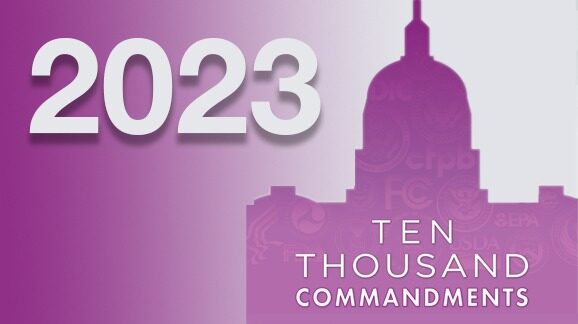Chapter 13: Federal Regulations Affecting State and Local Governments
Ten Thousand Commandments primarily emphasizes federal regulations imposed on the private sector. However, state and local officials’ complaints over federal mandates’ overriding their own priorities resulted in the Unfunded Mandates Act of 1995. That law requires the Congressional Budget Office to produce cost estimates for mandates affecting state, local, and tribal governments above the then threshold of $50 million.
Pandemic and post-pandemic spending and regulation affecting small business, states, and localities may lead to a new alignment that again induces a reluctant Congress to pull back. Recent infrastructure and investment legislation have affected the relationship between the federal and state and local governments (not to mention with citizens themselves), very likely raising the saliency of federal encroachment on local roles, concerns, and prerogatives.
As Figure 25 shows, agencies report that 387 of the 3,690 rules in the fall 2022 Agenda pipeline will affect local governments, an increase of 50 percent over Trump’s final year count of 258 (and 19 percent greater than Biden’s own count in 2021). That includes all stages—active, completed, and long-term. In Trump’s fall 2020 Agenda, 46 of 258 local actions were deemed deregulatory for Executive Order 13771 purposes across the active, completed, and long-term categories, which brings Biden’s to 82 percent over Trump’s net 212 local rules. Rules affecting local governments have not been this high since 2000.
Turning to the total number of regulatory actions affecting state governments, one finds 550, a 34 percent increase over Trump’s tally of 409 total actions affecting state governments in 2020, of which 72 were deemed deregulatory for Executive Order 13771 purposes, across the active, completed, and long-term categories. Rules affecting state governments have not been this high since 2001.
The number of rules affecting state and local governments has not reattained the pre–Unfunded Mandates Reform Act level depicted in 1994, but that appears to be where things are headed under the Biden administration. Particularly where legislation generates new unfunded mandates, state and local concerns could again influence regulatory reform measures.
These concerns, even pre-pandemic and even pre-Trump, had never dissipated. At the 2016 Legislative Summit of the National Conference of State Legislatures (NCSL), for example, a “Standing Committee on Budgets and Revenue” issued a resolution: “The growth of federal mandates and other costs that the federal government imposes on states and localities is one of the most serious fiscal issues confronting state and local government officials.” Even in that pre-pandemic era, the NCSL called for “reassessing” and “broadening” the 1995 Unfunded Mandates Reform Act. Meanwhile that same year, several state attorneys general wrote to House and Senate leadership expressing concerns over federal agencies’ “failing to fully consider the effect of their regulations on States and state law,” and issued an appeal for strengthening the Administrative Procedure Act.

CBO reports that between 2006 and 2019, 190 laws were passed that imposed 420 intergovernmental mandates on states and localities. Ending before 2020, this depiction does not cover pandemic and post-pandemic legislation, nor regulatory mandates that can come from agencies acting unilaterally. According to this official CBO data, while most do inflict some costs, few of the mandates through 2019 exceed the statutory threshold for requiring official estimates. This threshold was $50 million over a mandate’s first five years, and $77 million now.
However, the Unfunded Mandates Reform Act is not applicable to many rules and programs, which could be another impetus for reform. Of the 2,651 active rules in the fall 2022 Agenda, for example, only three acknowledge unfunded mandates on state, local, or tribal governments. Two are related to tobacco standards for flavoring in cigars and cigarettes, and one is on health-related electronic signatures certification.
Among 443 completed actions, only EPA’s amendments on “National Emission Standards for Hazardous Air Pollutants for Major Sources: Industrial, Commercial, and Institutional Boilers and Process Heaters” is acknowledged as an unfunded mandate. There are only two long-term actions acknowledged to impose unfunded mandates: (a) drug labeling barcode requirements; and (b) the Department of Labor’s ongoing pursuit of “COVID-19 Vaccination and Testing Emergency Temporary Standard” as a proposed rule, in defiance of a Supreme Court stay of its actions.
The Unified Agenda does recognize and report on a few additional unfunded mandates on the private sector, but not many. There are only 13 active, 5 completed, and 4 long-term rules in the pipeline. These are likely undercounts. Mandated agency disclosures are a mess, the same as many other regulatory cost and impact disclosures. Rectifying the situation could be part of the 118th Congress’s regulatory liberalization agenda.
